Tooth and Claw
The Hot-Blooded Dinosaurs: A Revolution in Paleontology
By Adrian J. Desmond

23 Jul, 2023
Adrian J. Desmond’s 1975 The Hot-Blooded Dinosaurs: A Revolution in Paleontology is a non-fiction account of a revolution in paleontology. Keen-eyed readers may be able to work out for themselves which particular subfield of paleontology was being revolutionized.
Dinosaurs! Relics of a pre-Noachian era? Dimly aware, clumsily lumbering outsized lizards? Or something else entirely?
Desmond advocates for “something else entirely.”
Rather than focus solely on the then-current state of dinosaur research, Desmond opts for a historical approach, taking the reader on a tour of the field from its very earliest days through to the early 1970s. He provides useful context for why particular models held sway when they did. Among other things, he establishes paleontology as a constantly evolving field, one in which interpretation of evidence is often shaped by pre-existing assumptions. Science does not occur in a cultural vacuum.
This is, of course, in service of the case he wishes to present that the time has come for another great reassessment of dinosaurs, as grand in its way as abandoning Biblical models or the realization that many dinosaurs were bipedal. Specifically, the reigning model that dinosaurs were cold-blooded and lethargic is not, Desmond feels, supported by the evidence. Instead, disco-era research points towards warm-blooded, energetic beasts.
Although his text is just 287 pages long, of which a fair portion consists of end-notes and an index, Desmond presents two centuries of research in a concise, informative manner. Also, large portions of the account are surprisingly amusing, particularly where scientific rivals Marsh and Cope are concerned.
The interpretation for which Desmond campaigns is old hat now, itself superseded by more nuanced models in light of evidence not available half a century ago. See, for example, the omission of meteor impact as the likely culprit for the K/T extinction, now an essential part of the consensus. In 1975 that was nowhere on anyone’s radar. At time of publication, the subtitle was justified: at least to the layperson, this was a dramatic new view of dinosaurs.
Although one cannot help but notice that Desmond’s rhetorical tools include presenting arguments he feels are unconvincing as the claims of, well, self-deluding knuckleheads. No doubt this won him friends and allies. That Galilean1 gambit aside, Desmond conveys his arguments effectively, in a very readable style. Half a century later, the work still entertains and informs the layperson. How an actual paleontologist would feel about it I could not say.
The Hot-Blooded Dinosaurs is out of print but used copies are surprisingly common and affordable.
A thumbnail sketch of the contents:
1 — The Crown of Creation
The recognition by natural philosophers that dinosaurs were a class apart and early attempts to understand what the evidence was saying.
2 — The Tyrant Finds Its Feet
Scientists arrive at the or at least a modern view of dinosaurs.
3 — The Race Is to The Swift, The Battle to The Strong
If dinosaurs were lethargic, low-energy beasts, why do so many of them have skeletons more appropriate for lithe, energetic sprinters?
4 — The Dark Ages
How could classical dinosaurs have dominated puny mammals for so long?
5 — Stranding of The Titans
A discussion of sauropods’ likely environmental niches as interpreted in the past and in the present.
6 — A Griffin Rescues Evolution
Just how are birds related to dinosaurs? What does this imply about dinosaurs?
7 — Phantoms from Hell
Pterosaurs: weird ass flying vertebrates but definitely not dinosaurs. Or birds, for that matter.
8 — The Coming of Armageddon: A Cosmic Cataclysm?
What catastrophe annihilated the dinosaurs along with many other species across the planet?
After pointing out that dinosaur-specific explanations cannot account for the extinction of non-dinosaurian species, Desmond focuses on supernovae, although he also points out the evidence suggests that dinosaurs were declining, possibly for climate-related reasons, well before the abrupt terminal event.
Meteor impact is nowhere on the menu2: Luis and Walter Alvarez, and Jan Smit, would not suggest the culprit was a meteor for a good half decade after this book was published. Chicxulub not identified as the impact spot until even later. Science marches on.
The book has black and white illustrations, the centre of the book has black and white plates, and there is a short but functional index.
1: As featured in Galileo’s famed work Dialogue Concerning the Two Chief World Systems, in which the arguments for the system Galileo saw as outdated are placed in the mouth of a character named Simplicio.
2: Nor are the Deccan Traps mentioned, as far as I can see. I am not conversant with the timeline of large igneous province research.
